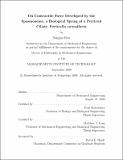| dc.contributor.advisor | Paul Matsudaira and Matthew J. Lang. | en_US |
| dc.contributor.author | Ryu, Sangjin | en_US |
| dc.contributor.other | Massachusetts Institute of Technology. Dept. of Mechanical Engineering. | en_US |
| dc.date.accessioned | 2010-05-25T19:22:49Z | |
| dc.date.available | 2010-05-25T19:22:49Z | |
| dc.date.copyright | 2009 | en_US |
| dc.date.issued | 2009 | en_US |
| dc.identifier.uri | http://hdl.handle.net/1721.1/54876 | |
| dc.description | Thesis (Ph. D.)--Massachusetts Institute of Technology, Dept. of Mechanical Engineering, 2009. | en_US |
| dc.description | This electronic version was submitted by the student author. The certified thesis is available in the Institute Archives and Special Collections. | en_US |
| dc.description | Cataloged from student-submitted PDF version of thesis. | en_US |
| dc.description | Includes bibliographical references (p. 135-143). | en_US |
| dc.description.abstract | Vorticella convallaria, a sessile ciliated protozoan, has an about 100 m long stalk that retracts the zooid toward a substrate in a few milliseconds generating the contractile force in the order of 10 nN. The spasmoneme, the contractile organelle inside the stalk, is a mechanochemical engine employing calcium ions as the energy source. In this thesis, I evaluate the lower and upper bounds of the contraction force of the Vorticella stalk and analyze the contraction dynamics and energetics. The lower limit is the peak contraction force in normal contraction, and Stokes' law was used with the contraction force equated to the drag force on the spherically shrunken zooid. However, contraction-induced water ow does not satisfy approximations for Stokes' law because the Stokes number and Reynolds number greater than unity show that the induced ow is not only transient but also non-creeping and because the visualized ow shows that it is limited by the substrate. Instead of Stokes' law, I employ computational uid dynamic simulations and propose a contraction force estimation model. Simulation-based estimates reveal that the combined effect of the unsteadiness, finite Reynolds numbers and the substrate comprises 35% of the total force and that the work done in the early phase of contraction and the maximum power output are similar regardless of the medium viscosity. To measure the upper limit, the isometric force of the spasmoneme, I apply viscous uid ow to Vorticella with a micro fluidic channel. | en_US |
| dc.description.abstract | (cont.) As the drag force increases, the cell contracts over shorter distance with lower speed, and latency between the zooid and stalk contraction increases whereas contraction propagation is not affected. The spasmoneme develops the contraction force at a rate of 4050 nN/msec. The isometric force, in the order of 100 nN, linearly depends on the stalk length, and this linear dependence (2.5 nN/1 m of the spasmoneme) enables estimating contractile force per lament of the spasmoneme. In terms of energetics, Vorticella in ow behaves differently than it does in stagnant media: the total work is constant regardless of the stall force whereas the maximum power output decreases as the stall force increases. | en_US |
| dc.description.statementofresponsibility | by Sangjin Ryu. | en_US |
| dc.format.extent | 143 p. | en_US |
| dc.language.iso | eng | en_US |
| dc.publisher | Massachusetts Institute of Technology | en_US |
| dc.rights | M.I.T. theses are protected by
copyright. They may be viewed from this source for any purpose, but
reproduction or distribution in any format is prohibited without written
permission. See provided URL for inquiries about permission. | en_US |
| dc.rights.uri | http://dspace.mit.edu/handle/1721.1/7582 | en_US |
| dc.subject | Mechanical Engineering. | en_US |
| dc.title | On contractile force developed by the Spasmoneme, a biological spring of a peritrich ciliate Vorticella convallaria | en_US |
| dc.type | Thesis | en_US |
| dc.description.degree | Ph.D. | en_US |
| dc.contributor.department | Massachusetts Institute of Technology. Department of Mechanical Engineering | |
| dc.identifier.oclc | 612433300 | en_US |
